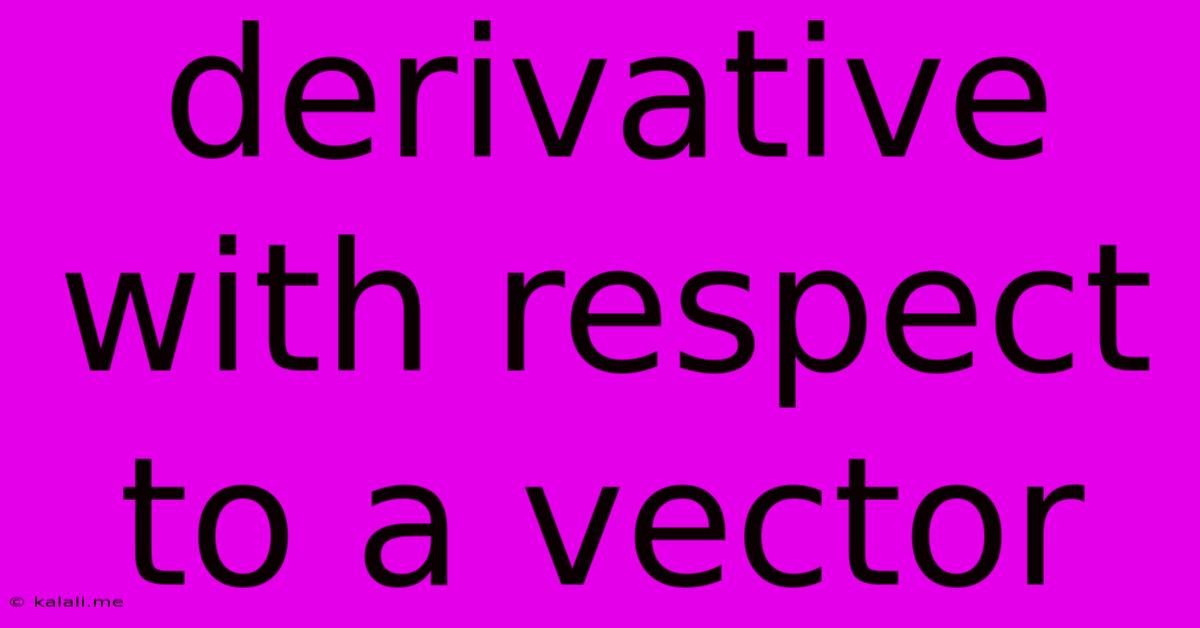Derivative With Respect To A Vector
Kalali
Jun 09, 2025 · 3 min read

Table of Contents
Understanding Derivatives with Respect to a Vector
This article explores the concept of taking a derivative with respect to a vector, a crucial element in advanced calculus and fields like machine learning, physics, and engineering. While seemingly complex, understanding the underlying principles makes it manageable. This guide breaks down the process, explaining the intuition behind it and providing practical examples.
The derivative of a scalar function with respect to a vector generalizes the familiar concept of a gradient. Instead of considering the rate of change with respect to a single variable, we examine the rate of change with respect to multiple variables simultaneously, represented as a vector. This provides a richer understanding of how the function changes in various directions.
What is a Vector?
Before diving into the derivative, let's ensure a solid understanding of vectors. A vector is a quantity possessing both magnitude and direction. It can be represented as an ordered list of numbers (its components) and often depicted as an arrow in multi-dimensional space. Examples include velocity (speed and direction) and force (magnitude and direction of push/pull).
The Gradient: The Foundation
The gradient of a scalar function, denoted as ∇f, is the vector of its partial derivatives. Each component represents the rate of change of the function along a particular coordinate axis. For a function f(x, y), the gradient is:
∇f(x, y) = (∂f/∂x, ∂f/∂y)
The gradient points in the direction of the steepest ascent of the function. This is a fundamental concept in optimization algorithms, where we want to find the maximum or minimum of a function.
Derivatives with Respect to Vectors: Beyond the Gradient
While the gradient is a special case, the concept extends beyond scalar functions. Consider a function f: R<sup>n</sup> → R<sup>m</sup> which maps an n-dimensional vector to an m-dimensional vector. The derivative with respect to a vector in this context is represented by the Jacobian matrix.
The Jacobian Matrix: The Generalization
The Jacobian matrix is a generalization of the gradient. It's an m x n matrix where each element (i, j) represents the partial derivative of the i-th component of the output vector with respect to the j-th component of the input vector:
J<sub>ij</sub> = ∂f<sub>i</sub>/∂x<sub>j</sub>
The Jacobian matrix provides a linear approximation of the function's behavior near a specific point. It tells us how a small change in the input vector affects the output vector.
Applications: Where is it Used?
Derivatives with respect to vectors are essential in several areas:
- Machine Learning: Backpropagation in neural networks relies heavily on calculating gradients and Jacobian matrices for optimization.
- Physics: Describing the motion of objects, calculating forces and fields often involve vector-valued functions and their derivatives.
- Robotics: Controlling robot movements requires precise calculations of changes in position and orientation, which involves derivatives of vector-valued functions.
- Computer Graphics: Rendering realistic images frequently utilizes vector calculations and derivatives for tasks like lighting and shading.
Example: A Simple Illustration
Let's consider a simple function mapping a 2D vector to a scalar: f(x, y) = x² + y². The gradient is:
∇f(x, y) = (2x, 2y)
This gradient vector shows the direction of steepest ascent at any point (x, y).
Conclusion: A Powerful Tool
Understanding derivatives with respect to vectors is crucial for tackling complex problems in various fields. While the mathematics might initially seem challenging, breaking it down into its constituent parts—vectors, gradients, and Jacobians—makes the concept more accessible. With practice and application, mastery of this concept opens doors to advanced problem-solving capabilities.
Latest Posts
Latest Posts
-
Jesus The Alpha And The Omega
Jun 09, 2025
-
How Legacy System Communicate To Salesforce Using Connected App
Jun 09, 2025
-
What Is The Sixth Hour In The Bible
Jun 09, 2025
-
Jesus Curses The Fig Tree Meaning
Jun 09, 2025
-
How To Test A Water Line For Leaks
Jun 09, 2025
Related Post
Thank you for visiting our website which covers about Derivative With Respect To A Vector . We hope the information provided has been useful to you. Feel free to contact us if you have any questions or need further assistance. See you next time and don't miss to bookmark.